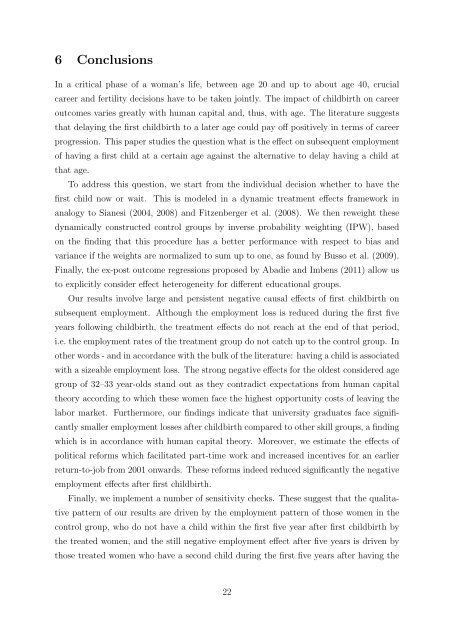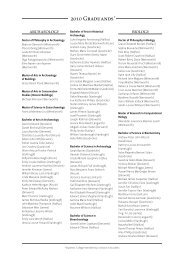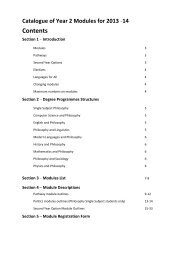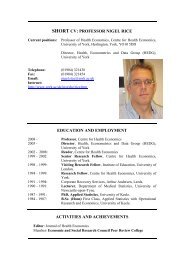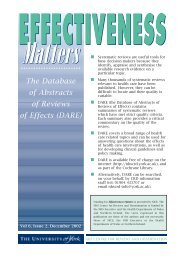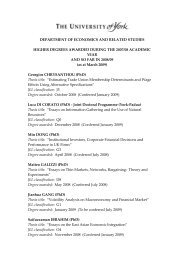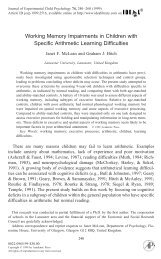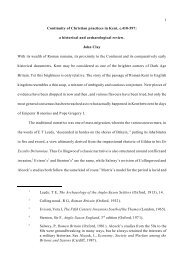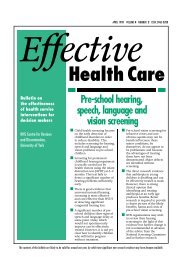Causal effects on employment after first birth - A ... - University of York
Causal effects on employment after first birth - A ... - University of York
Causal effects on employment after first birth - A ... - University of York
Create successful ePaper yourself
Turn your PDF publications into a flip-book with our unique Google optimized e-Paper software.
6 C<strong>on</strong>clusi<strong>on</strong>sIn a critical phase <strong>of</strong> a woman’s life, between age 20 and up to about age 40, crucialcareer and fertility decisi<strong>on</strong>s have to be taken jointly. The impact <strong>of</strong> child<strong>birth</strong> <strong>on</strong> careeroutcomes varies greatly with human capital and, thus, with age. The literature suggeststhat delaying the <strong>first</strong> child<strong>birth</strong> to a later age could pay <strong>of</strong>f positively in terms <strong>of</strong> careerprogressi<strong>on</strong>. This paper studies the questi<strong>on</strong> what is the effect <strong>on</strong> subsequent <strong>employment</strong><strong>of</strong> having a <strong>first</strong> child at a certain age against the alternative to delay having a child atthat age.To address this questi<strong>on</strong>, we start from the individual decisi<strong>on</strong> whether to have the<strong>first</strong> child now or wait. This is modeled in a dynamic treatment <str<strong>on</strong>g>effects</str<strong>on</strong>g> framework inanalogy to Sianesi (2004, 2008) and Fitzenberger et al. (2008). We then reweight thesedynamically c<strong>on</strong>structed c<strong>on</strong>trol groups by inverse probability weighting (IPW), based<strong>on</strong> the finding that this procedure has a better performance with respect to bias andvariance if the weights are normalized to sum up to <strong>on</strong>e, as found by Busso et al. (2009).Finally, the ex-post outcome regressi<strong>on</strong>s proposed by Abadie and Imbens (2011) allow usto explicitly c<strong>on</strong>sider effect heterogeneity for different educati<strong>on</strong>al groups.Our results involve large and persistent negative causal <str<strong>on</strong>g>effects</str<strong>on</strong>g> <strong>of</strong> <strong>first</strong> child<strong>birth</strong> <strong>on</strong>subsequent <strong>employment</strong>. Although the <strong>employment</strong> loss is reduced during the <strong>first</strong> fiveyears following child<strong>birth</strong>, the treatment <str<strong>on</strong>g>effects</str<strong>on</strong>g> do not reach at the end <strong>of</strong> that period,i.e. the <strong>employment</strong> rates <strong>of</strong> the treatment group do not catch up to the c<strong>on</strong>trol group. Inother words - and in accordance with the bulk <strong>of</strong> the literature: having a child is associatedwith a sizeable <strong>employment</strong> loss. The str<strong>on</strong>g negative <str<strong>on</strong>g>effects</str<strong>on</strong>g> for the oldest c<strong>on</strong>sidered agegroup <strong>of</strong> 32–33 year-olds stand out as they c<strong>on</strong>tradict expectati<strong>on</strong>s from human capitaltheory according to which these women face the highest opportunity costs <strong>of</strong> leaving thelabor market. Furthermore, our findings indicate that university graduates face significantlysmaller <strong>employment</strong> losses <strong>after</strong> child<strong>birth</strong> compared to other skill groups, a findingwhich is in accordance with human capital theory. Moreover, we estimate the <str<strong>on</strong>g>effects</str<strong>on</strong>g> <strong>of</strong>political reforms which facilitated part-time work and increased incentives for an earlierreturn-to-job from 2001 <strong>on</strong>wards. These reforms indeed reduced significantly the negative<strong>employment</strong> <str<strong>on</strong>g>effects</str<strong>on</strong>g> <strong>after</strong> <strong>first</strong> child<strong>birth</strong>.Finally, we implement a number <strong>of</strong> sensitivity checks. These suggest that the qualitativepattern <strong>of</strong> our results are driven by the <strong>employment</strong> pattern <strong>of</strong> those women in thec<strong>on</strong>trol group, who do not have a child within the <strong>first</strong> five year <strong>after</strong> <strong>first</strong> child<strong>birth</strong> bythe treated women, and the still negative <strong>employment</strong> effect <strong>after</strong> five years is driven bythose treated women who have a sec<strong>on</strong>d child during the <strong>first</strong> five years <strong>after</strong> having the22


